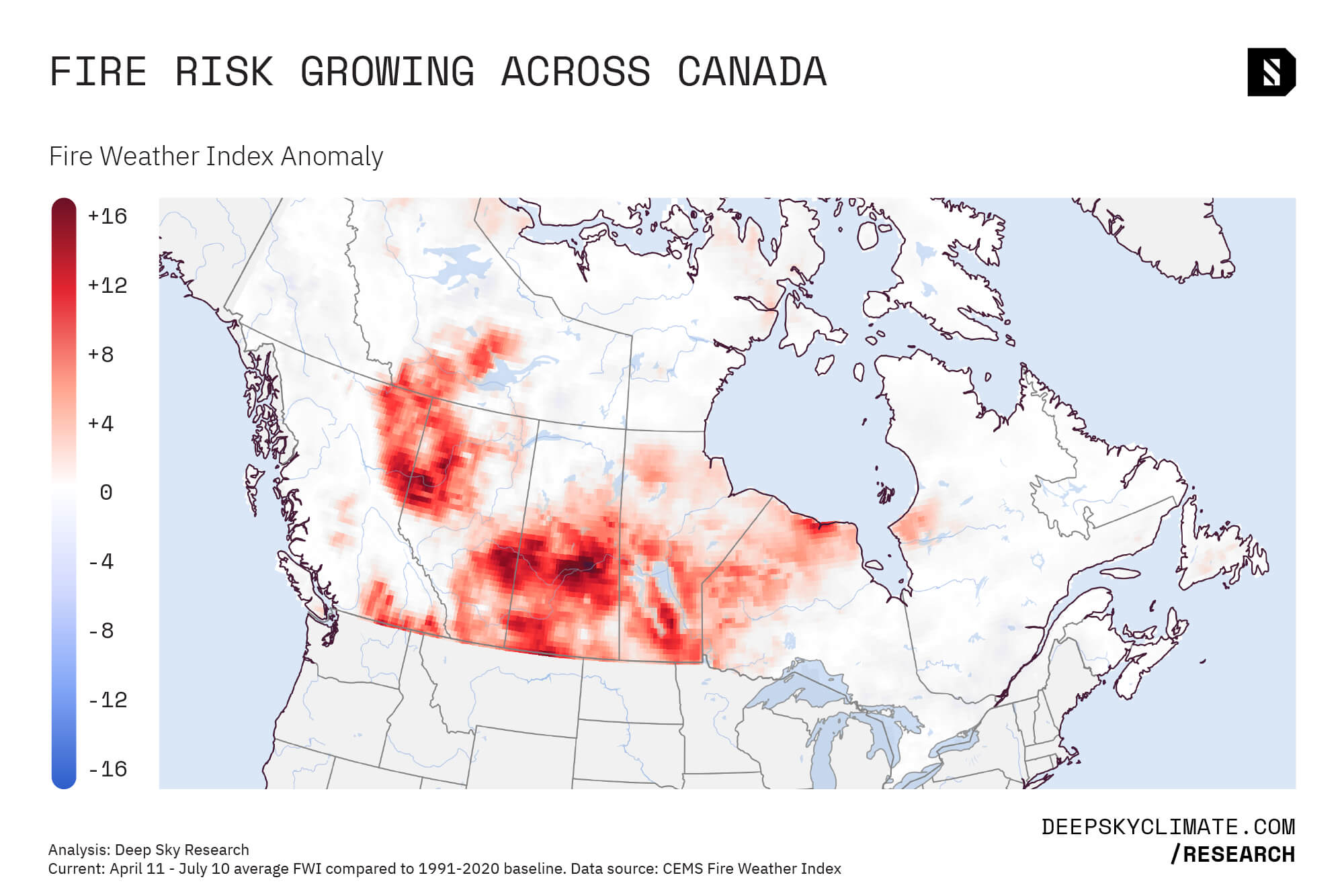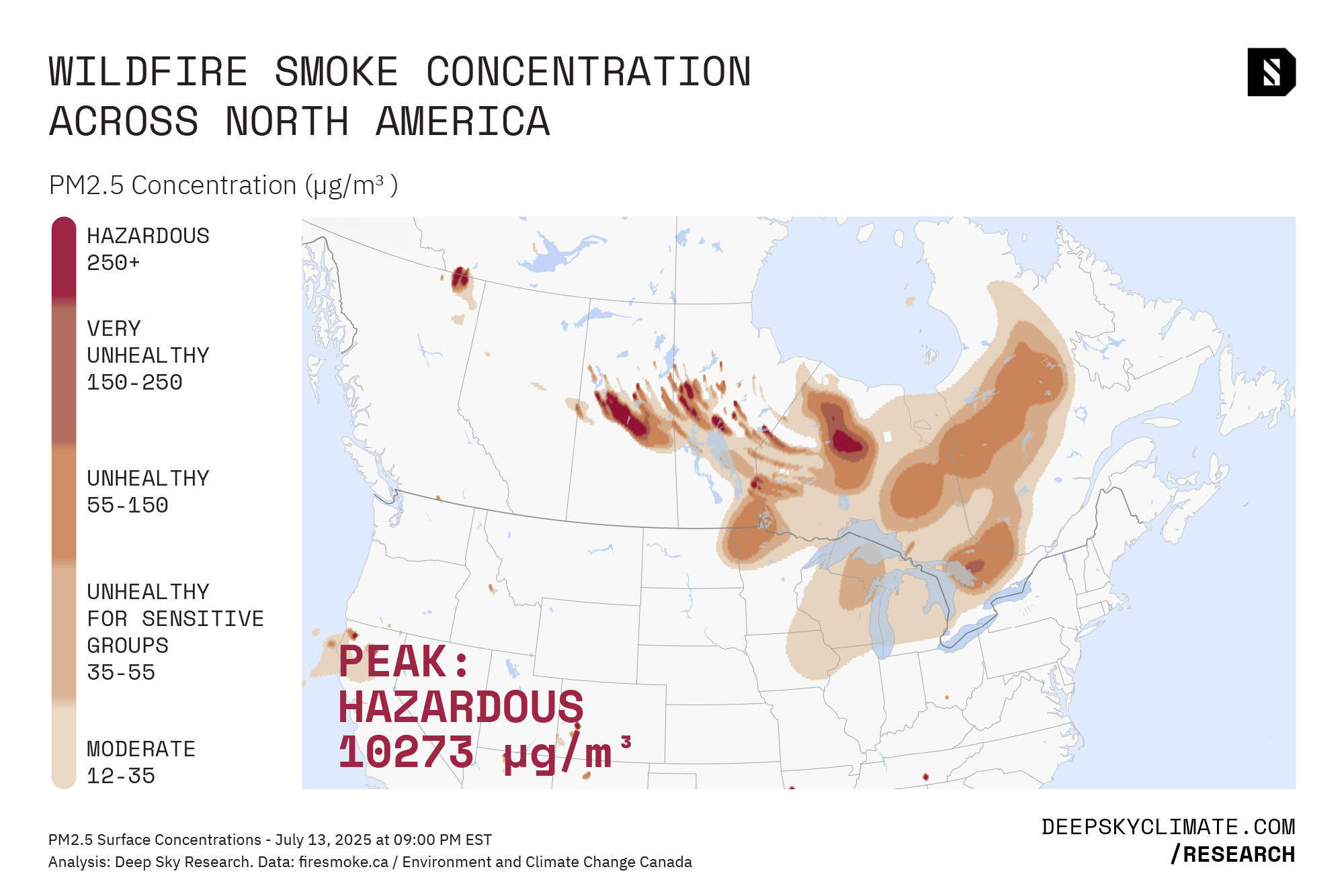Subscribe to our newsletter
The place for unfiltered climate news and Deep Sky developments.

No Clear End in Sight
Wildfire risk escalates across Canada as summer conditions intensify
Large swathes of Canada are now facing elevated wildfire risk, well above what was previously normal for this time of year. The current fire activity aligns closely with forecasts from Deep Sky Research’s June wildfire report, which identified a widespread pattern of elevated spring fire risk across much of the country—particularly in the western and central provinces.
As of mid-July, several of the regions highlighted in the report—including Northwest Alberta, Central Saskatchewan, and Southern Manitoba—have experienced devastating wildfires. These fires have forced evacuations, destroyed homes and infrastructure, and blanketed communities across North America in smoke.
Spring Conditions Signal Summer Severity
Spring fire risk is proving to be a strong predictor of summer fire activity. Hot and dry conditions throughout June and early July have compounded the danger. Today southern parts of British Columbia, Alberta, Saskatchewan, and Manitoba face elevated risk. These areas, home to larger populations and critical infrastructure, are more vulnerable to both property damage and health impacts compared to more remote wildfire zones.
In 2024, Canadian wildfires caused $7.7 billion in insurance damages. The Jasper fire alone was estimated at $1.2 billion in damages. If this year continues at its current pace, there is a high probability that 2025 wildfires will cause greater damages than 2024.

Smoke Spreads Across the Continent
Toronto, Ottawa, Montreal, and Saskatoon among other places experienced dangerously smoky air in recent days, resulting in poor air quality warnings and rising health concerns. The US also felt the impacts of fires burning in Canada with smoke spreading across Minneapolis, Detroit, Chicago and much of the US midwest. The smoke is primarily coming from wildfires in Saskatchewan, Manitoba, and more recently Northern Ontario and the prevailing winds spread it eastward blanketing the continent from Iowa to the Maritimes.

Smoke Health Risks: What to Know
Elevated levels of particulate matter in the air are known to trigger respiratory issues, increase emergency room visits, and exacerbate chronic conditions—especially for children, the elderly, and people with asthma or heart disease. High risk individuals are encouraged to stay indoors to avoid wildfire smoke, with windows and doors closed, and air conditioning turned on if possible. A portable air filter can help remove smoke particles indoors and clean the air. If individuals must be outdoors, masks or respirators are advised to reduce smoke exposure and physical activity should be limited. In the US and Canada, outdoor air quality can be monitored using the Air Quality Index (AQI) or on a phone weather app. Canadians can also monitor Air Quality Health Index (AQHI) on the ECCC website.
Risk Expands Eastward
The threat is no longer confined to western Canada. Northern Ontario and parts of Northern Quebec are now also experiencing higher-than-normal fire risk for this stage of the summer, suggesting that the eastern wildfire season could still intensify.
Outlook: No Clear End in Sight
With no major weather shifts forecasted and much of the country still under hot, dry conditions, the 2025 wildfire season shows no signs of easing. Canadians and Americans alike should prepare for continued smoky conditions and the potential for further evacuations and fire-related disruptions.
With "zombie fires" that burn underground all year long there is really no end to wildfire season anymore. Excluding those, in some parts of Western Canada wildfire season will soon be 100 days longer than pre-climate change. The wildfire season started early in 2025 and should be expected to end late.
Deep Sky Research will continue to monitor fire activity and provide updates as new data becomes available.




